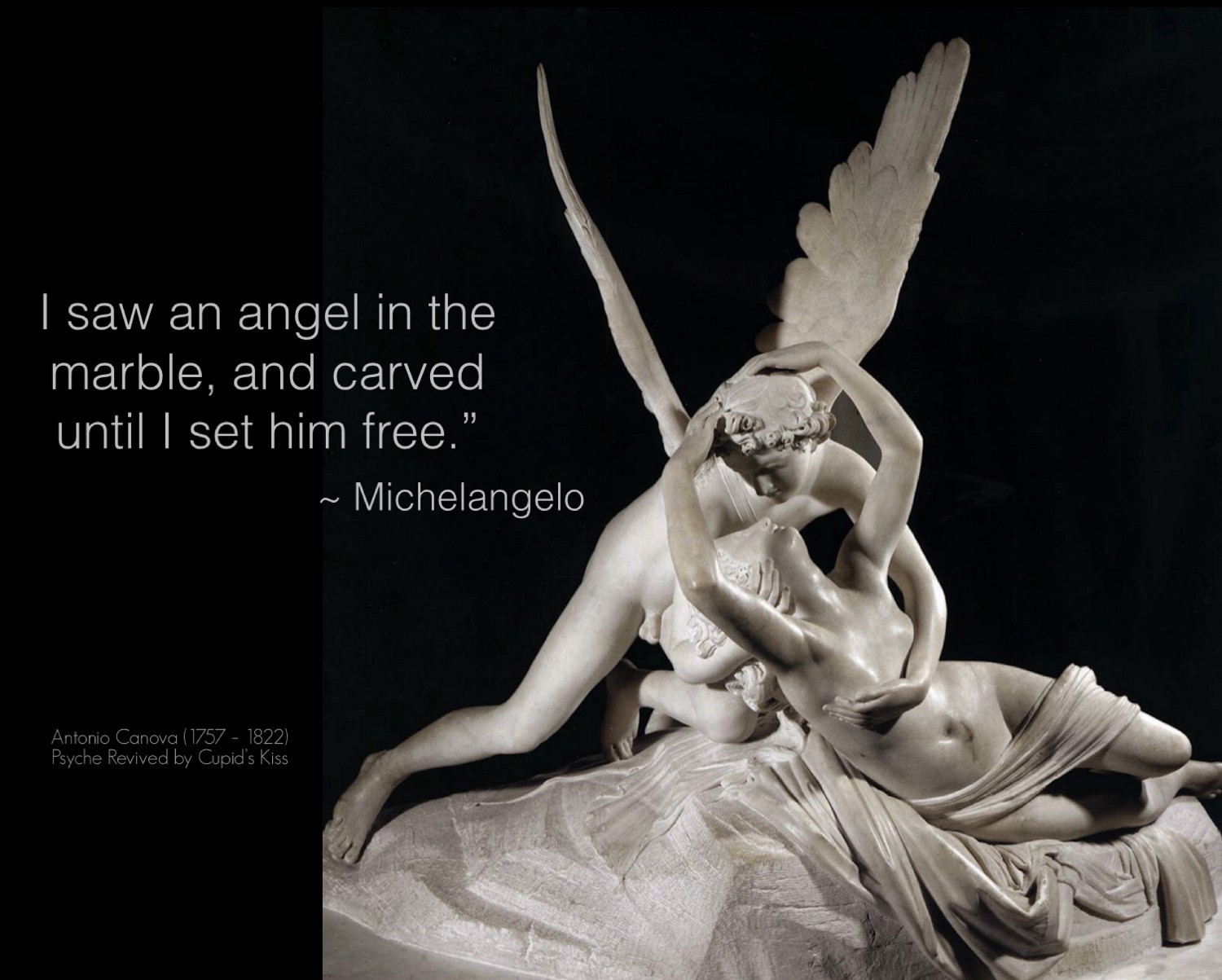With the passing of another year, it seems that one of the most asked questions is, “Where did the time go?” This is also one of the most popular times of the year to ask, “What did it all mean, anyway?”
When we look beyond ourselves to see all of the things that took our time over the past year, and when we look closely and honestly, we discover that we took our time. Yes, amidst our masterful multi-tasking, striking so many things off our to-do list, constantly delivering to others, and diligently fulfilling so many responsibilities, we find ourselves in a scary moment of reflection that fills us with the feeling that we are perhaps not as fulfilled as we should be given the magnitude of our activities over the past year.
Michelangelo said, “I saw an angel in the marble, and carved until I set him free.” With the belief that we have within us a beautiful and divine being waiting for us to pick up the tools and be the sculptor of our lives, we can choose to use each moment to transform our being and our lives into great masterpieces.
The Buddha said, “No one saves us but ourselves. No one can and no one may. We ourselves must walk the path.” In each moment, we can choose to save ourselves from our trivial pursuits and walk the path of our most meaningful pursuits.
In the moments after you read this, you will make a choice. What will you do? Will you quickly jump to the next “to-do” or will you take a moment to reflect, and answer the questions that may arise, “Where do I choose to place my time?” “What will I make of this next moment?” “How will I come closer to the angel that is waiting for me to shape it into my being?” Perhaps you may choose to pause just long enough to hear the question you most want to ask of yourself, and to answer most honestly for yourself. “Are you happy?” “Are you living your purpose?” “Are you treating yourself well?” “Are you loving yourself?” “Are you making yourself a priority?” Perhaps you will take a few precious moments to close your eyes and give yourself permission to imagine all you want for yourself — yes, just for you. Just for precious you.
Perhaps, as you imagine all you desire for yourself, you will see images that give you goosebumps, images that fill you with life, with playfulness, with joy, with a sense that you are here to be part of something greater. To be your fullest you. There is a reason you have that sense, and that you see those images — it is because they are planted within you, waiting for you to nurture them. Waiting for you to give the seeds of your soul your attention.
The greatest gift you have to give yourself is your presence. Your choice to give yourself your presence — your love, your attention, your time — is in your own hands. You have the power to activate your greater being, your higher consciousness, your smarter brain, by the presence you give yourself.
Thankfully, science is showing us more and more ways that we can re-train ourselves — out of our unconscious choices that hold us back, and into our conscious choices that move us toward the life, fulfillment and happiness we desire. We hold the key to unlock the door and step onto new paths to the life we want through the time we choose to give ourselves.

Only in a state of presence, can we overcome our habitual auto-responses that keep us spinning in the same cycles, and instead, act from enlightened responses that take us to a higher state of living and being. So, how do we choose presence versus busyness, and cultivate enlightened-responses versus auto-responses?
Here are a few practices that have been inspired by neuroscience and Buddhist mind-training techniques that you may find helpful. The secret is to choose one that resonates with you, and commit to practicing it for at least 30 days in order to start to re-train your brain.
- Single-Pointed Meditation (Mind training for mental clarity and focus).
Try this simple meditation several times throughout your day for just a few minutes at a time, and experience how much your mental clarity and focus improve day by day.
Steps to a Simple Single-Pointed Meditation Exercise:
- Place any small object on a desk or table approx. 2–3 feet in front of you so that you are looking down at the object at about a 45 degree angle. The object can be anything upon which you can place your attention — a pen, a cup, an eraser, a coin.
- For about two minutes, place all of your focus on the object and commit to memory as much detail as you can. Do not allow any thoughts, noises, objects in your peripheral vision, or other distractions to take your mind away from your focus on the object. If your mind wanders, re-focus on the object. Breathe fully and gently.
- For about three minutes, close your eyes and keep the image in your “mind’s eye.” Recall as much detail as you can. Do not allow any thoughts, noises, or other distractions to take your mind away from your focus on the object in your “mind’s eye.” If your mind wanders, re-focus on the object. Breathe fully and gently.
- Slowly open your eyes. Allow the sense of concentrated presence to remain with you as you continue your day. Repeat throughout your day, especially when you need to re-focus and gain clarity.
The point of this meditation, simply, is to train your mind to remain clear and focused, even amidst the rising and falling of distractions. As you train your mind this way in meditation, your mind will start “acting” this way outside of meditation. You will become less easily distracted, and more attuned to be directed by your conscious choices.
2. Analytical Meditation (Mind training to cultivate presence and equanimity with emotions).
Train your brain to stay in a state of equanimity — without getting “hooked” on either “positive” or “negative” emotions. Neurochemistry is increasingly showing us that we can master our emotions — we can “power-up” the neurochemicals that bring about positive beliefs and mental states, and “power-down” negative beliefs and mental states. We can also train our brains to remain neutral amidst the rising and falling of positive and negative emotions. Buddhist philosophies and practices have focused on this training for over 2500 years in order to bring about physical and mental well-being. That is, we are in control of our mental responses to stimuli, not our “untamed” and primitive mind. We can start to re-train our brain and take control with a short amount of practice each day. A simple method to bring about a positive mental state is to identify an image that brings you joy, love, compassion, strength, or whichever positive emotion you wish to cultivate. In the morning and evening spend just five minutes bringing this image to mind and allow your mind and your being to be immersed in the positive feeling of the image. Whenever your mind wanders from the image, bring it back into focus. Throughout your day, when you are triggered into a negative state, bring your positive image to mind and allow your “untamed” mind to be brought back to your desired positive, or neutral state. Keep practicing this to cultivate the positive and calming emotions you want in your life. When you start to cultivate positive mental states from within during your daily practice, you will see them start to manifest around you.

3. Minimize Multi-Tasking and Interruptions. The enemy of mindfulness is multi-tasking (now more frequently referred to as “task-switching” in order to capture its interruptive nature). Not only are you training your brain to have a short attention span and minimizing your ability to be mindful, but also you are giving yourself a “false” reward by rewarding the instant gratification that comes from achieving small tasks, as opposed to remaining patiently and steadily focused on the more time-consuming and significant tasks. Do you know it takes the brain about 23 minutes to re-focus once its focus has been switched away from a task? In addition, the same study from the University of California Irvine showed that multi-tasking and interruptions resulted in “…a higher workload, more stress, higher frustration, more time pressure, and effort.” Only we can create the best conditions to reduce task-switching and interruptions — and most of the time it means managing the expectations of others, which often requires a conversation. So have the conversations and make the changes you need to reduce interruptions and stay focused on one priority at a time. You may be surprised that time starts slowing down for you, and you are more able to make significant progress toward all that is most important and meaningful in your life.
4. Start Small and Commit To Your Progress. Too often we sabotage ourselves in the early stages of our path to change by “biting off more than we can chew.” You can think big and dream big, but starting with small steps to which you can commit every day is your best chance of achieving your big dream. Visualize the dream you have, and then ask yourself, “What is the smallest thing I can do today?” Once you do the smallest thing, go a little further day by day. The small steps each day will lead to change that lasts, rather than large steps done infrequently and inconsistently. Ask any athlete, successful business person, or celebrity — there are seldom “overnight successes.” So dream big, start small, celebrate your successes, and keep progressing on your path to all you want in your life.
5. Take Care of Yourself. The best way to be present with yourself is to make your health and well-being your number one priority. Your mindfulness will suffer if your health suffers. You may feel that you are taking some big strides by over-working yourself, but if you consistently run on empty, you will eventually break down. Create healthy habits to take care of yourself each day. These can be small and simple things that renew you and bring you back to you. Eat well, make time for exercise, go for walks, get seven to nine hours of quality sleep each night, drink eight glasses of water, create an act of joy in your day, express gratitude, spend time with a loved one, give a random act of kindness, and minimize alcohol (especially before sleeping). Explore and experiment with new ways to bring yourself back to you, and allow yourself to experience the gift of all that is within you, and all that is waiting to help you on your path to your greatest, happiest, and most fulfilled you.

Most of all, remember, you are here as an essential and extraordinary part of creation, so create the essential and extraordinary life you are here to live — one moment at a time.
Have A Thriving 2017!
Originally published at medium.com


